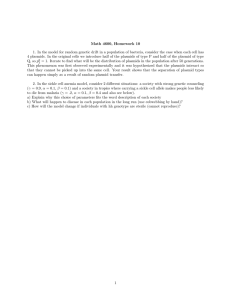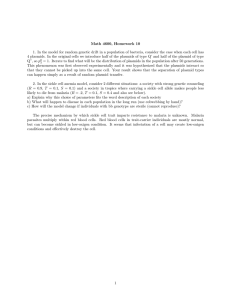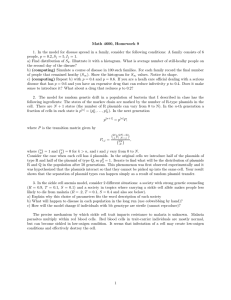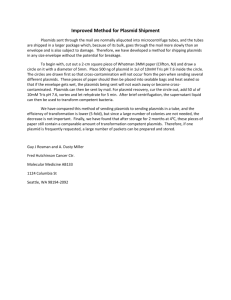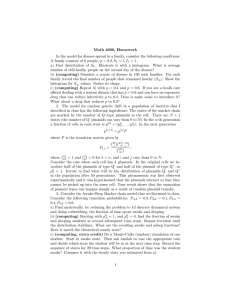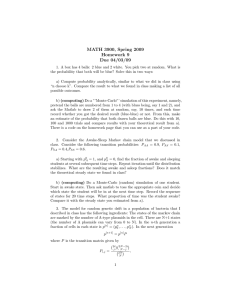Molecular Cloning of Virulence Genes from stewartiit
advertisement
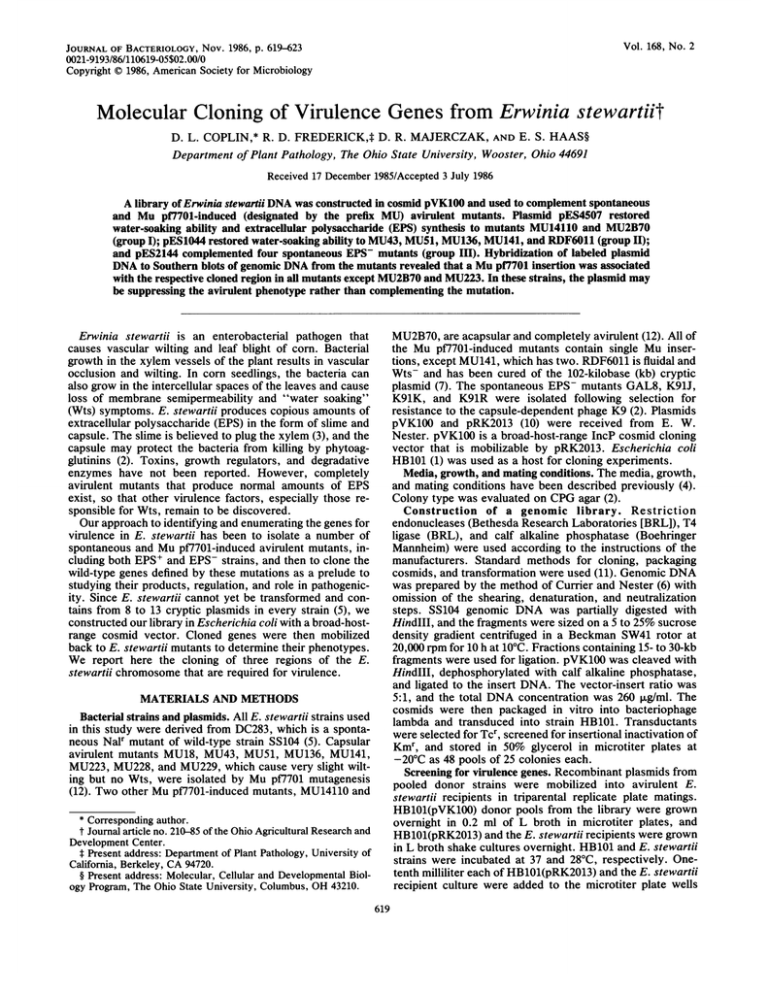
Vol. 168, No. 2 JOURNAL OF BACTERIOLOGY, Nov. 1986, p. 619-623 0021-9193/86/110619-05$02.00/0 Copyright © 1986, American Society for Microbiology Molecular Cloning of Virulence Genes from Erwinia stewartiit D. L. COPLIN,* R. D. FREDERICK,t D. R. MAJERCZAK, AND E. S. HAAS§ Department of Plant Pathology, The Ohio State University, Wooster, Ohio 44691 Received 17 December 1985/Accepted 3 July 1986 A library of Erwinia stewartii DNA was constructed in cosmid pVK100 and used to complement spontaneous and Mu pf7701-induced (designated by the prefix MU) avirulent mutants. Plasmid pES4507 restored water-soaking ability and extracellular polysaccharide (EPS) synthesis to mutants MU14110 and MU2B70 (group I); pES1044 restored water-soaking ability to MU43, MU51, MU136, MU141, and RDF6011 (group II); and pES2144 complemented four spontaneous EPS- mutants (group Ill). Hybridization of labeled plasmid DNA to Southern blots of genomic DNA from the mutants revealed that a Mu pf7701 insertion was associated with the respective cloned region in all mutants except MU2B70 and MU223. In these strains, the plasmid may be suppressing the avirulent phenotype rather than complementing the mutation. Erwinia stewartii is an enterobacterial pathogen that causes vascular wilting and leaf blight of corn. Bacterial growth in the xylem vessels of the plant results in vascular occlusion and wilting. In corn seedlings, the bacteria can also grow in the intercellular spaces of the leaves and cause loss of membrane semipermeability and "water soaking" (Wts) symptoms. E. stewartii produces copious amounts of extracellular polysaccharide (EPS) in the form of slime and capsule. The slime is believed to plug the xylem (3), and the capsule may protect the bacteria from killing by phytoagglutinins (2). Toxins, growth regulators, and degradative enzymes have not been reported. However, completely avirulent mutants that produce normal amounts of EPS exist, so that other virulence factors, especially those responsible for Wts, remain to be discovered. Our approach to identifying and enumerating the genes for virulence in E. stewartii has been to isolate a number of spontaneous and Mu pf7701-induced avirulent mutants, including both EPS+ and EPS- strains, and then to clone the wild-type genes defined by these mutations as a prelude to studying their products, regulation, and role in pathogenicity. Since E. stewartii cannot yet be transformed and contains from 8 to 13 cryptic plasmids in every strain (5), we constructed our library in Escherichia coli with a broad-hostrange cosmid vector. Cloned genes were then mobilized back to E. stewartii mutants to determine their phenotypes. We report here the cloning of three regions of the E. stewartii chromosome that are required for virulence. MU2B70, are acapsular and completely avirulent (12). All of the Mu pf7701-induced mutants contain single Mu insertions, except MU141, which has two. RDF6011 is fluidal and Wts- and has been cured of the 102-kilobase (kb) cryptic plasmid (7). The spontaneous EPS- mutants GAL8, K91J, K91K, and K91R were isolated following selection for resistance to the capsule-dependent phage K9 (2). Plasmids pVK100 and pRK2013 (10) were received from E. W. Nester. pVK100 is a broad-host-range IncP cosmid cloning vector that is mobilizable by pRK2013. Escherichia coli HB101 (1) was used as a host for cloning experiments. Media, growth, and mating conditions. The media, growth, and mating conditions have been described previously (4). Colony type was evaluated on CPG agar (2). Construction of a genomic library. Restriction endonucleases (Bethesda Research Laboratories [BRL]), T4 ligase (BRL), and calf alkaline phosphatase (Boehringer Mannheim) were used according to the instructions of the manufacturers. Standard methods for cloning, packaging cosmids, and transformation were used (11). Genomic DNA was prepared by the method of Currier and Nester (6) with omission of the shearing, denaturation, and neutralization steps. SS104 genomic DNA was partially digested with HindIII, and the fragments were sized on a 5 to 25% sucrose density gradient centrifuged in a Beckman SW41 rotor at 20,000 rpm for 10 h at 10°C. Fractions containing 15- to 30-kb fragments were used for ligation. pVK100 was cleaved with HindIII, dephosphorylated with calf alkaline phosphatase, and ligated to the insert DNA. The vector-insert ratio was 5:1, and the total DNA concentration was 260 ,ug/ml. The cosmids were then packaged in vitro into bacteriophage lambda and transduced into strain HB101. Transductants were selected for Tcr, screened for insertional inactivation of Kmr, and stored in 50% glycerol in microtiter plates at -20°C as 48 pools of 25 colonies each. Screening for virulence genes. Recombinant plasmids from pooled donor strains were mobilized into avirulent E. stewartii recipients in triparental replicate plate matings. HB101(pVK100) donor pools from the library were grown overnight in 0.2 ml of L broth in microtiter plates, and HB101(pRK2013) and the E. stewartii recipients were grown in L broth shake cultures overnight. HB101 and E. stewartii strains were incubated at 37 and 28°C, respectively. Onetenth milliliter each of HB101(pRK2013) and the E. stewartii recipient culture were added to the microtiter plate wells MATERIALS AND METHODS Bacterial strains and plasmids. All E. stewartii strains used in this study were derived from DC283, which is a spontaneous Nalr mutant of wild-type strain SS104 (5). Capsular avirulent mutants MU18, MU43, MU51, MU136, MU141, MU223, MU228, and MU229, which cause very slight wilting but no Wts, were isolated by Mu pf7701 mutagenesis (12). Two other Mu pf7701-induced mutants, MU14110 and * Corresponding author. t Journal article no. 210-85 of the Ohio Agricultural Research and Development Center. t Present address: Department of Plant Pathology, University of California, Berkeley, CA 94720. § Present address: Molecular, Cellular and Developmental Biology Program, The Ohio State University, Columbus, OH 43210. 619 620 COPLIN ET AL. containing donors from the library. A multipoint inoculator was then used to transfer 0.3 pxl of the mixture to the surface of a fresh L agar plate. Bacteria were allowed to conjugate for 6 h and then were transferred with a velveteen pad to L agar containing tetracycline and nalidixic acid. If the transconjugants were to be screened first for EPS production, CPG agar was used instead of L agar. Patches of transconjugants were suspended in Tween 40-containing buffer at 10i cells/ml and inoculated into the whorls of corn seedlings as described below. Donor pools that restored virulence to an avirulent mutant were purified by dilution plating, and 48 single colonies wete rescreened as described above. Virulence tests. A whorl inoculation method was used to measure Wts ability. Bacteria were suspended in 0.01 M potassium phosphate buffer (pH 7:0) containing 0.2% (vol/vol) Tween 40 at 107 cells/ml, and inocula (0.1 to 0.3 ml per plant) were added to the whorls of 8-day-old cv. Earliking sweet corn seedlings. Plants were kept in a controlled environment chamber at 31°C, 30,000 lux, and a 16-h light-8h dark cycle. Wts symptoms were rated after 4 days. Plants inoculated in this manner do not develop wilting symptoms and the infection does not become systemic. Virulence was also determined by injecting seedlings, grown as described above, with a bacterial suspension (9 x ios cells per ml) at 1 cm above the soil line. Plants were rated on the following scale: 1 = no symptoms, 2 = Wts lesions, 3 = numerous lesions with slight wilting, 4 = severe wilting, and 5 = death. DNA manipulations. Procedures for plasmid DNA isolation, agarose gel electrophoresis, restriction analysis, nick translation, and Southern blot hybridization have been described previously (5, 7, 11). EPS determination. EPS was extracted from bacterial suspensions made from 48-h DB minimal agar plate cultures. Bacteria were scraped from the plates and suspended at 0.4 A540 in buffered saline (10 mM potassium phosphate buffer, pH 7.0, 15 mM NaCl, 1 mM MgSO4.7H20), and the cells were removed by successive centrifugations at 3,000 x g for 30 min and 16,000 x g for 60 min at 4°C. EPS was precipitated with 3 volumes of 95% ethanol overnight at -20oC and then redissolved in distilled water. Total carbohydrates based on glucose were determined by the anthrone method (9). RESULTS Construction of a genomic library. Genomic DNA from wild-type E. stewartii SS104 was partially digested with HindIII, ligated into pVK100, packaged into bacteriophage lambda, and transduced into Escherichia coli HB101. The library consisted of 48 mixtures or pools of strains, each containing 25 transductants. Greater than 99% of the Tcr transductants were KmS and contained cosmids with insertions. Agarose gel electrophoresis showed that the average insert size was 21 + 2 kb. Theoretical calculations (11) based on this insert size and an assumed genome size of 2.6 x 109 daltons predicted a greater than 99% probability that the 1,200 clones in our library contained any given gene. Preliminary screening for recombinant plasmids complementing the auxotrophic markers of HB101 further indicated that the library was representative; two clones complementing leuB6 and five clones complementing proA2 were obtained. Identification of clones containing vfrulence genes. Recombinant plasmids in each donor library pool were mobilized by pRK2013 into a set of avirulent mutants in triparental replica J. BACTERIOL. plate matings, and the resulting mixtures of transconjugants were tested for virulence. Forty-eight colonies were then purified from each donor library pool that produced virulent transconjugants and retested as described above. Chimeric plasmids restoring virulence to any of the mutants were subsequently analyzed by restriction with HindIlI to identify common fragments and eliminate sibling clones. Our initial screening resulted in the following unique plasmids: pES4014 and pES4507 restored virulence to MU2B70; pES1044, pES2213, and pES3140 to MU141; pES3219 and pES502 to MU229; and pES440 to MU223. Restoration of virulence to MU14110 and MU2B70 was also accompanied by a change from butyrous to fluidal colony type (Fig. 1). MU18 was not complemented by any plasmid from the library. In some cases, cloned DNA appeared to partially complement certain mutations. For example, MU228 and MU229 were leaky and caused only a few lesions on 10% of the inoculated plants. The virulence of MU228 was increased by 10 different plasmids from the library, but only a few of these shared homologous regions. Similar results were obtained with 11 plasmids that partially restored virulence to MU229. Consequently, we assumed that the phenotype of these mutants was easily suppressed and did not study them further. We also considered the possibility that some weak pathogenic reactions might be due to mixed cultures resulting from either reversion of the mutant or loss of the test plasmid. Bacteria were reisolated from lesions caused by transconjugants from 37 crosses involving 26 different plasmids. Ten colonies from each isolation were retested for virulence and loss of Tcr. None of the reisolates were fully virulent, and in general, the plasmids were stable in planta; 92.4% of the colonies tested retained the recombinant plasmid. Sixteen of the plasmids were stable, and the remaining 10 plasmids were lost from 5 to 50% of the colonies. Due to the presence of similar-sized resident plasmids in E. stewartii, we were not able to ascertain whether any of the recombinant plasmids had integrated into the chromosome. In a similar experiment, the library was screened for clones which restored EPS production (fluidal colony type) to four spontaneous EPS- mutants of DC283. Plasmid pES2144 restored fluidal colony type and full virulence to GAL8, K91J, K91K, and K91R. It also complemented the Gal-, galactose-sensitive phenotype of GAL8. Complementation tests. Following initial isolation and restriction analysis, a set of unique plasmids was selected for further study. These plasmids were used to test all combinations of clones and mutants for restoration of Wts. Three major complementation groups were observed (Table 1). Plasmids pES4507 and pES1044 defined complementation groups I (MU14110 and MU2B70) and II (MU43, MU51, MU136, MU141, and RDF6011), respectively. Plasmid pES2144 complemented mutants in group III, which included the EPS- strains GAL8, K91J, K91K, and K91R. In addition, the virulence of MU223 was restored by three plasmids, pES440, pES1044, and pES3219, and partial Wts but not EPS production was restored to MU14110 by pES1044. Comparison of recombinant plasmids. Restriction analysis and Southern blot hybridization studies with the plasmids listed in Table 1 revealed that pES4507 and pES4014 (group I) had a common 9.2-kb HindlIl fragment. Similarly, pES1044, pES2213, and pES3140 (group II) had a common 12.8-kb HindIII fragment. pES440, pES502, pES2144, and pES3219 did not have similar HindIII restriction patterns and did not hybridize with either the pES1044 or pES4507 VIRULENCE GENES OF E. STEWARTII VOL. 168, 1986 621 A: FIG. 1. Wts lesions produced MU14110(pES4507). on sweet corn seedlings (top) and colony type (bottom) of (A) DC283, (B) MU14110, and (C) probe. None of the plasmids hybridized to a probe made from total SS104 cryptic plasmid DNA, indicating that in all cases the cloned DNA was chromosomal. To distinguish between complementation and suppression, we sought to associate the Mu pf7701 insertion mutations in the avirulent strains with the corresponding cloned region. pES440, pES1044, pES3219, and pES4507 were hybridized to blots of HindlIl-cleaved genomic DNA from the avirulent mutants in their respective complementation A Mu pf7701 insertion was located in a fragment corresponding to the 9.2-kb HindlIl fragment of pES4507 in MU14110. This fragment was missing in MU14110, and new 6.4- and 12.0-kb fragments were present (data not shown). Likewise, the Mu pf7701 insertions in MU43, MU51, MU136, and MU143 were located in the region corresponding to the 12.8-kb HindlIl fragment of pES1044. New fragments of 19.4 and 2.9 kb were found in MU43 (Fig. 2, lane C), 13.4 and 8.9 kb in MU51 (Fig. 2, lane D), and 18.4 groups. TABLE 1. Restoration of virulence to avirulent mutants by recombinant plasmids Wts ratinga Plasmid pES2144 pES4507 pES4014 pES1044 pES2213 pES3140 pES3219 pES502 pES440 MU43 MUS1 MU141 MU136 RDF6011 MU223 MU14110 MU2B70 GAL8 K91J 0 0 0 3.0 2.7 2.5 0 3.0 0 0 0 0 3.0 2.8 2.5 3.0 0 0 0 0 0 3.0 2.5 2.5 0 0 0 0 0 0 3.0 2.5 3.0 0 0 0 0 0 0 1.5 0 0 0 0 0 0 0 0 1.3 0 0 2.0 0 2.1 0 3.0 3.0 2.0 0 0 0 0 0 0 3.0 3.0 0 0 0 0 0 0 3.0 0 0 0 0 0 0 0 0 3.0 0 0 0 0 0 0 0 0 a Plants were inoculated by the whorl assay method at 107 cells per ml. Values indicate the amount of water soaking at 4 days after inoculation and are averages of two to nine experiments with three replications each. Wts was scored from 0 (no Wts symptoms) to 3 (severe Wts with exudate). 622 .W*-w::},je">i.;:siw< - ['._EX.F ,.i . - *:. E:. .::..P: r+:. . a COPLIN ET AL. r v n :: : ,. .. . '" w E .... . .... .. F;. :. fl - s! .. ..ar., ... .. .. E-S-, ... .......... .X g, eSe - eeSe <- *:.:::: ::: e >>>v<< S !F:'' *: .: :: ...: ::::. '':_: " ' ... ::eM .: : ....... :>. FIG. 2. Southern blot of HindIll-cleaved genomic DNA from avirulent mutants (A) MU223, (B) MU229, (C) MU43, (D) MU51, (E) MU136, (F) MU141, and (G) RDF6011 and (H) wild-type strain SS104 probed with 32P-labeled pES1044 DNA. Arrows indicate positions of 12.8- (top) and 1.8-kb (bottom) HindlIl fragments. and 3.9 kb in MU141 (Fig. 2, lane F). The 12.8-kb Hindlll fragment was missing in MU136 (Fig. 2, lane E), but junction fragments were not observed. In addition, a spontaneous insertion mutation was located in the 1.8-kb Hindlll frag- J. BACTERIOL. ment of pES1044 in RDF6011. This fragment was missing in this strain, and a new 2.9-kb band was present (Fig. 2, lane G). This 1.8-kb fragment was not found in the other group II plasmids, pES2213 and pES3140, which did not complement RDF6011. The Mu pf7701 insertions in MU2B70, MU229 (Fig. 2, lane B), and MU223 (Fig. 2, lane A) were not detected with any of the probes. We previously reported hybridization of the left-end EcoRI fragment of Mu to HindlIl-digested chromosomal blots of the Mu pf7701induced mutants (12). In the present experiment, the 6.4-, 8.9-, 2.9-, and 3.9-kb fragments of MU14110, MU51, MU43, and MU141, respectively, were the same sizes as the left-end join fragments that we detected in these strains with the Mu probe. Relationship between virulence and amount of EPS produced. Carriage of pES4507 increased the amount of EPS produced by wild-type cultures of E. stewartii and the amount of bacterial exudate associated with lesions (Fig. 1). Normally E. stewartii colonies are not fluidal on medium lacking a readily fermentable sugar; however, colonies of DC283(pES4507) and MU14110(pES4507) were quite slimy on L agar. To determine whether pES4507 increased the virulence of wild-type and mutant strains, we measured the EPS production and pathogenicity of strains DC283, DC283(pES4507), MU14110, and MU14110(pES4507). pES4507 increased the amount of EPS produced in culture from 0.5 x 10-14 to 43 x 10-l' g/cell in MU14110 and from 22 x 10-14 to 88 x 10-14 g/cell in DC283. No differences in the rate of symptom expression or final disease severity with respect to wilting and Wts were observed between DC283, DC283(pES4507), and MU14110(pES4507) (Fig. 3). The 50% effective doses determined by whorl assay for DC283, DC283(pES4507), and MU14110(pES4507) were 19, 20, and 13 cells per plant, respectively; these were not significantly different (5% level). In contrast, the 50% effective dose for MU14110 was in excess of 5 x 109 cells per plant. Although pES1044 restored Wts ability to MU14110, it did not restore the ability to cause systemic wilt (Fig. 3) or produce EPS. MU14110(pES1044) produced only 10-14 g of EPS per cell. DISCUSSION We have used the broad-host-range cosmid cloning vector pVK100 to construct a genomic library of E. stewartii DNA 5.0_ 4.0, ccj co loco~ DAYS AFTER INOCULATION FIG. 3. Symptom development on sweet corn seedlings wound-inoculated with E. stewartii strains DC283 (0), DC283(pES4507) (0), MU14110 (LI), MU14110(pES4507) (A), and MU14110(pES1044) (A). The disease severity rating scale is described in the text. Each curve is an average for six replicates. VOL. 168, 1986 in Escherichia coli. The recombinant plasmids were readily mobilizable back into E. stewartii, and the absence of induced resistance to E. stewartii in corn allowed us to use the host as a positive selection for virulent bacteria in our preliminary screening. Hybridization studies showed that the cloned virulence genes originated from chromosomal rather than plasmid DNA. This is significant because cryptic plasmids constitute about 20% of the E. stewartii genome (5), and we had previously speculated that the avirulence of RDF6011 (group II) was due to the loss of plasmid pDC190 genes (7). Complementation tests identified three segments of chromosomal DNA that are required for virulence. Had more mutants been included in our study, we may have identified additional regions that contain virulence genes. The ability to do complementation tests with mobilizable cloning vectors offered the first usable genetic system for E. stewartii, because other means of genetic exchange, such as transducing phages, Hfr donors, and a transformation system, have not been found for this species. In the three complementation groups discussed above, the cloned DNA corresponded to the site of an insertion or deletion event in the avirulent mutation that it complemented. However, in a number of cases, an entirely different DNA fragment appeared to also complement the same mutation, e.g., MU43 by pES502, MU51 by pES3219, MU223 by pES440, and MU14110 by pES1044, so that it was possible to observe suppression of the avirulent phenotype rather than true complementation. Such suppression could be brought about by stimulating alternate pathways for synthesis of the virulence factor or by altering global regulatory circuits. The Mu insertions in MU2B70 and MU223 were not revealed by any of the hybridization probes that we used, so their avirulence could be due to spontaneous mutations that were not detectable in our hybridization experiments. At present, it is unclear whether these plasmids and mutants represent additional complementation groups. Transposon mutagenesis and homogenotization experiments with pES440, pES502, and pES3219 should indicate whether the genes on these plasmids that are responsible for suppressing avirulence are themselves essential for pathogenicity. Complementation group III contained all of the spontaneous EPS- mutants, and both EPS synthesis and complete virulence were concomitantly restored to these mutants by pES2144. Recent work in our laboratory (P. J. Dolph and D. L. Coplin, Proc. VIth Int. Conf. Plant Pathogenic Bacteria, in press) has shown that pES2144 contains a major cluster of genes required for capsule biosynthesis that is positively regulated by a function which is missing in MU14110. Increasing the copy number of a positive regulatory gene could explain the stimulation of EPS synthesis that we saw in wild-type strains containing pES4507. A similar increase in capsule production has been reported in Escherichia coli cells containing multiple copies of rcsA, a positive regulator of colanic acid synthesis (8). The stimulation of presumably normal EPS synthesis in wild-type strains by pES4507 allowed us to determine whether increasing the amount of EPS produced by the pathogen increases its overall virulence. Although lesions caused by DC283(pES4507) exhibited more bacterial exudate on their surfaces, pES4507 did not affect other indica- VIRULENCE GENES OF E. STEWARTII 623 tors of pathogenicity. Therefore, the virulence of E. stewartii DC283 does not appear to be limited by the amount of slime that it normally produces. The concomitant restoration of both Wts and fluidal colony type to MU14110, GAL8, and K91J suggests that cell surface polysaccharides are involved in Wts. However, in group II mutants, which are EPS+ Wts-, and MU14110(pES1044), K91K, and K91R, which are EPS- Wts+, colony type does not appear to be correllated with Wts ability. Since the Wts factor probably has to pass through the plant cell wall to cause membrane damage, we feel that it is unlikely that a molecule as large as the capsular polysaccharide itself causes Wts. Instead Wts could be due to a related but smaller polysaccharide, or, alternatively, EPS could augment the action of a nonpolysaccharide toxin to cause the leaves to appear water soaked. ACKNOWLEDGMENTS Salaries and research support were provided by the U.S. Department of Agriculture under grant 83-CRCR-1-1205 from the Competitive Research Grants Office and by state and federal funds appropriated to the Ohio Agricultural Research and Development Center, The Ohio State University. We thank A. J. Wilson for the lambda in vitro packaging extracts. LITERATURE CITED 1. Boyer, H. W., and D. Roullard-Dussoix. 1969. A complementation analysis of the restriction and modification of DNA in Escherichia coli. J. Mol. Biol. 41:459-472. 2. Bradshaw-Rouse, J. J., M. A. Whatley, D. L. Coplin, A. Woods, L. Sequeira, and A. Kelman. 1981. Agglutination of strains of Erwinia stewartii with a corn agglutinin: correlation with extracellular polysaccharide production and pathogenicity. Appl. Environ. Microbiol. 42:344-350. 3. Braun, E. J. 1982. Ultrastructural investigation of resistant and susceptible maize inbreds infected with Erwinia stewartii. Phytopathology 72:159-166. 4. Coplin, D. L. 1978. Properties of F and P group plasmids in Erwinia stewartii. Phytopathology 68:1637-1643. 5. Coplin, D. L,, R. G. Rowan, D. A. Chisholm, and R. E. Whitmoyer. 1981. Characterization of plasmids in Erwinia stewartii. Appl. Environ. Microbiol. 42:599-604. 6. Currier, T. C., and E. W. Nester. 1976. Isolation of covalently closed circular DNA of high molecular weight from bacteria. Anal. Biochem. 76:431-441. 7. Frederick, R. D., and D. L. Coplin, 1986. Plasmid pDC190: distribution among Erwinia stewartii strains and nonassociation with virulence. Phytopathology 76:165-170. 8. Gottesman, S., P. Trisler, and A. Torres-Cabassa. 1985. Regulation of capsular polysaccharide synthesis in Escherichia coli K-12: characterization of three regulatory genes. J. Bacteriol. 162:1111-1119. 9. Hanson, R. S., and J. A. Phillips. 1981. Chemical composition, p. 328-364. In P. Gerhardt, R. G. E. Murray, R. N. Costilow, E. W. Nester, W. A. Wood, N. R. Krieg, and G. B. Phillips (ed.), Manual of methods for general bacteriology. American Society for Microbiology, Washington, D.C. 10. Knauf, V. C., and E. W. Nester. 1982. Wide host range cloning vectors: a cosmid clone bank of an Agrobacterium Ti plasmid. Plasmid 8:45-54. 11. Maniatis, T., E. F. Fritsch, and J. Sambrook. 1982. Molecular cloning: a laboratory manual. Cold Spring Harbor Laboratory, Cold Spring Harbor, N.Y. 12. McCammon, S. L., D. L. Coplin, and R. G. Rowan. 1985. Isolation of avirulent mutants of Erwinia stewartii using bacteriophage Mu pf7701. J. Gen. Microbiol. 131:2993-3000.
